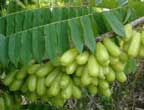Shree Matre Namaha
Dedicated to : Shree Devi Shakambari –Mother of Grains, Greens –All Food
for Shakambari Poornima 19th Jan 2011
It is said that in times of famine, Goddess Durga comes down and gives vegan food, (shaaka comes from Sanskrit. means vegetables and vegan food. Ambari means one who wears or bears) , to the hungry. That is why she is called "Shaka" + "Ambari" = 'Shaakambhari'.
Actually Shakambhari comes from Shakam joined with the root Bhri(Shaka = vegetables or food and root bhri = to nourish)
Share & Care is within reach--and in many ways -No doubt,very sobering thoughts at the beginning of a new year, but this Cooperative Effort for Collective benefit of Mankind is what is what have to factor in.Sankaranti ushers in a new period of rejuventaion and so we take up the Yajna Spirit. We in India Culture actually developed the Yajna Principle-applicable to all walks of life viz.Work, Share Cooperate, Receive ...Give--- back cycle...
Today whether it is tree planting or water conservation,the Yajna Principle is seen.
Sustainable Living and Working will be the only way to deal with challenges Ahead-
Introduction Part 1-
The term “BAHUVIDA YAJNA” is prescribed in our Scriptures. This approach benefits all as wealth produced therefore goes to the collective benefit of the entire world and all its denizens and thereby the “balance of nature” without exploitation, misuse or abuse gets established. Ecology, Environmental protection, etc. have been recognised in the last two decades after the last century of gross misuse of all resources resulting in de-forestation, pollution, water scarcity, floods, droughts, temperature changes – global warning, etc.
All this has been “Scientifically” recorded and acknowledged.
When we-family, organisation, or society work together in a “Cooperative Endeavour” the collective enterprise becomes a Yajna; the outcome is “Lok-Sangraha” which helps all.
Co-operation is at several planes and is not confined to the material plane only.
Thus subtle plane of existence and the powers that rule over are respected in the Panch Maha Yajnas. This is the path of long term good for all- “Shreyas”.
Modern Management often refers to this as “Sustainable Development” and thereby the Interdependence of Man and Nature which is an expression of the Divine as Natures balance (Prakruti) in so many forms is established..Thus ‘Yajna’ is seen as the “Kamadhenu”-- that fulfils all needs.All this, extends the Spirit of Yajna to a state of economic importance. i.e. the Artha aspect of the Purusharthas.
The principle of Parasparam is best illustrated in –
annad bhavanti bhutani
parjanyad anna-sambhavaha
yajnad bhavati parjanyo
yajnah karma-samudbhavaha
from Srimad Bhagavad Gita 3.14
“All living bodies subsist on food grains, which are produced from rains. Rains are produced by performance of yajna [sacrifice], and yajna is born of prescribed duties.”
Understanding parasparam bhava and Yajna
The Growth of a blade of Grass- sees the following all supporting and Cooperating.
1) Earth gives space to support growth.
2) Wind & Birds help in spreading the seeds.
3) The Sun - Rivers- Sea – Ocean, in fact all water bodies jointly workout an Evaporation & Condensation cycle for Rain clouds.
4) Finally again the Wind assists to blow clouds across and then these Rain showers spread across to help it grow.
These pics taken in my garden teach me this lesson so well.





















































